Madhubani art, originating 2,500 years ago in Bihar’s Mithila region, transforms walls, paper, and canvas with vibrant geometric patterns and symbolic motifs. Women artists traditionally use natural materials like turmeric, berries, and bamboo brushes to create five distinct styles—Bharni, Kachni, Godna, Tantrik, and Kohbar. Originally painted on mud walls during ceremonies, this living tradition gained global recognition after a 1934 earthquake revealed these hidden treasures. The colorful world of Madhubani holds centuries of stories waiting to be discovered.
Key Takeaways
- Madhubani art originated over 2,500 years ago in Bihar’s Mithila region, traditionally created by women on mud walls.
- Artists use natural materials like turmeric, flowers, and soot for pigments, with bamboo and cotton brushes for intricate details.
- Five distinct styles exist: Bharni, Kachni, Godna, Tantrik, and Kohbar, each with unique techniques and cultural significance.
- Symbolic motifs like fish (fertility), lotus (purity), and peacocks (love) form visual narratives reflecting spiritual beliefs.
- The art gained global recognition after a 1934 earthquake revealed it, with artists like Sita Devi winning prestigious awards.
Numeric List of 12 Second-Level Headings
Twelve distinct sections will guide readers through the vibrant world of Madhubani art, each exploring a different facet of this ancient Indian tradition.
From the humble beginnings in the Mithila region of Bihar to its global recognition today, the journey of this folk art form is truly amazing!
Women artists have passed down these techniques for generations, creating stunning scenes with vibrant colors and intricate patterns that tell stories of gods, nature, and everyday life.
The article unpacks the five main types of Madhubani painting traditions, explains the cultural significance behind popular motifs, and shows how these paintings connect to important life events.
Readers will discover how this art form, once created only on mud walls of homes, has evolved while maintaining its distinctive, eye-catching style.
The Ancient Origins of Madhubani Art in Bihar
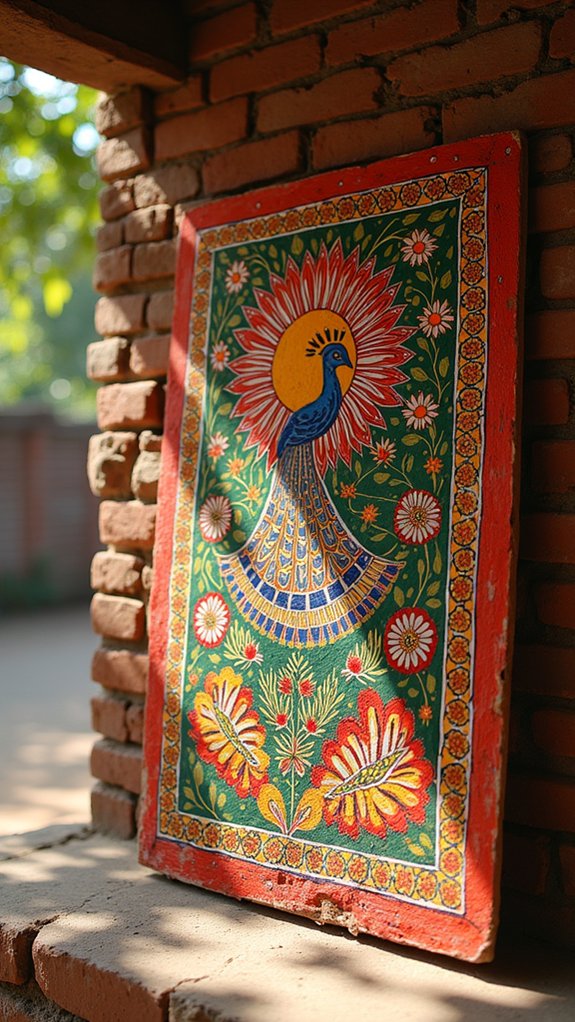
Tradition runs deep in the Mithila region of Bihar, where Madhubani art began its colorful journey over 2,500 years ago. The first known Madhubani painting was actually commissioned by King Janak for his daughter Sita’s wedding—yes, the same Sita from Hindu mythology!
This ancient art form was originally the realm of women from Brahmin and Kayastha communities, known as Dukhranis, who passed down their artistic secrets through generations.
Imagine grandmothers teaching granddaughters how to create vibrant designs on freshly plastered mud walls using natural colors from berries, plants, and even cow dung!
Ancestral wisdom flows through fingers as nature’s palette transforms humble walls into living canvases.
Madhubani remained a hidden treasure until 1934, when an earthquake accidentally revealed these magnificent wall paintings.
Their cultural significance was later recognized globally, and in the 1980s, this Bihar-born tradition finally received the prestigious Geographical Indication status it deserved.
Traditional Techniques and Materials Used by Mithila Artists
When artists in Mithila sit down to create their masterpieces, they reach not for expensive art supplies, but for the bounty of nature around them. Madhubani artists transform simple ingredients into breathtaking works that burst with vibrant colors and tell ancient tales!
| Material | Source | Use in Painting |
|---|---|---|
| Pigments | Turmeric, flowers, berries | Creating yellow, red, and purple hues |
| Black | Soot from oil lamps | Outlining figures and patterns |
| Brushes | Bamboo twigs, cotton | Applying intricate patterns |
| Surface | Mud walls, handmade paper | Canvas for traditional techniques |
| Binding | Rice powder paste | Securing colors to surface |
Every inch of a Mithila painting teems with life, as artists fill all empty spaces with dots, lines, and geometric shapes. These traditional techniques have passed through generations, preserving the vibrant cultural heartbeat of Bihar.
Five Distinct Styles: Bharni, Katchni, Tantrik, Godna, and Kohbar
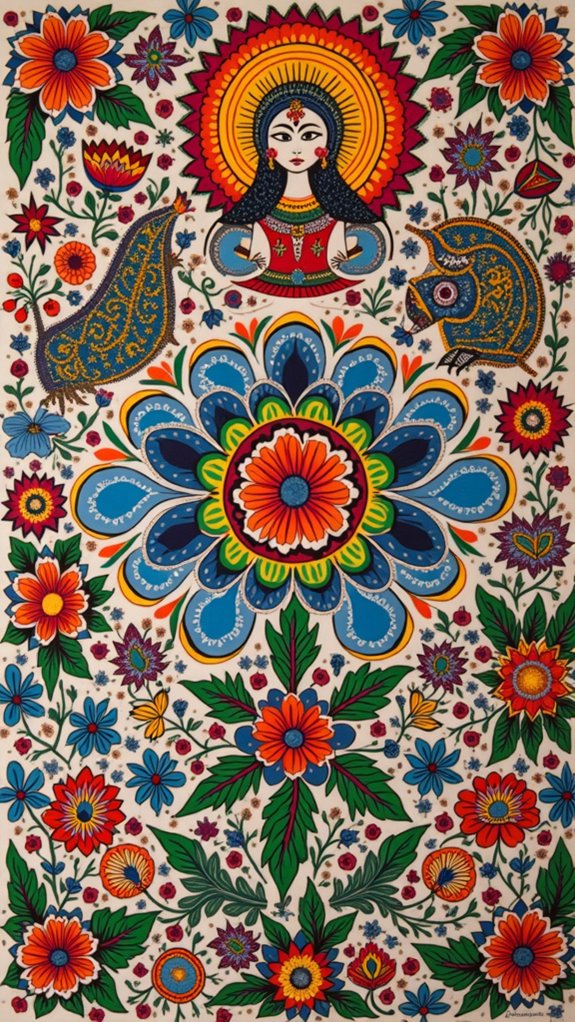
Madhubani artistry blossoms into five spectacular styles, each with its own personality and story to tell!
The Bharni Style uses eye-popping colors to illustrate myths and gods with incredible details.
Vibrant hues bring ancient deities to life in Bharni Style, where every brushstroke celebrates divine mythology in spectacular detail.
Kachni Style, in contrast, relies on super-fine lines in one or two colors, creating amazing textures inspired by nature’s beauty.
The tribal-inspired Godna Style features black-and-white geometric patterns and floral motifs that tell stories passed down through generations.
For spiritual seekers, Tantrik Style depicts cosmic energies and divine figures used in meditation practices.
Finally, the romantic Kohbar Style celebrates weddings with symbols of love and fertility—think lotus flowers and fish swimming together!
These five approaches show how versatile Madhubani art can be, whether it’s adorning village walls or modern art galleries.
Mythological Narratives and Cultural Stories in Madhubani Paintings
Divine stories burst to life through the vibrant brushstrokes of Madhubani artists, who transform ancient legends into stunning visual feasts! About 70% of these colorful masterpieces feature Hindu deities like Rama, Krishna, and Sita, bringing mythological narratives right into people’s homes and hearts.
The Bharni style, with its eye-popping colors, takes viewers on a journey through epic tales from the Ramayana and Mahabharata. Artists add intricate designs of lotus flowers and peacocks that aren’t just pretty—they’re packed with meaning about love and prosperity!
During wedding ceremonies, special Kohbar paintings celebrate love and fertility, connecting newlyweds to divine couples. These visual narratives do something amazing: they preserve cultural stories while building bridges between today’s world and ancient traditions. Pretty cool, right?
Powerful Symbolism: Fish, Lotus, and Peacock Motifs
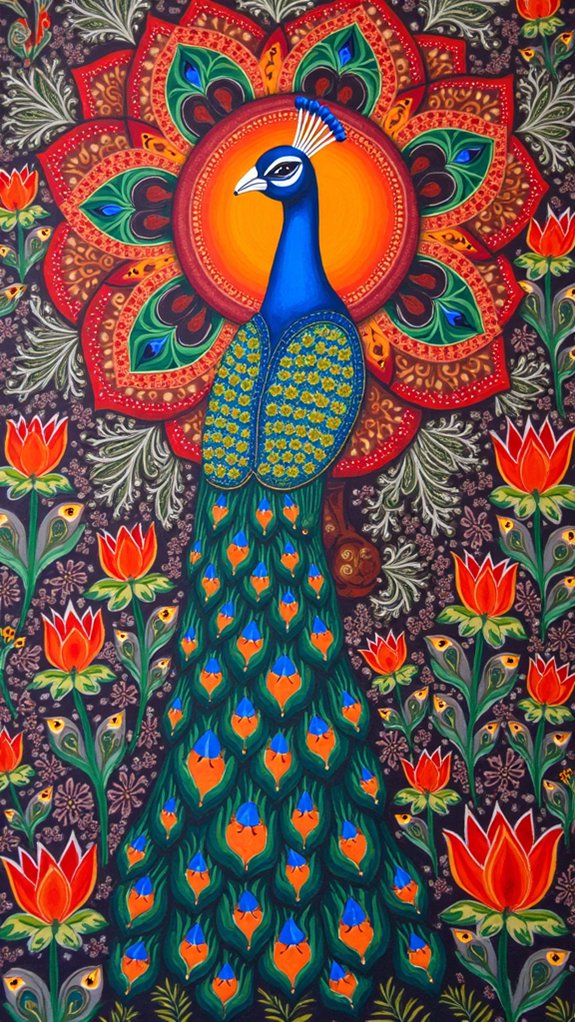
Madhubani artists weave powerful symbolism across their paintings through the fish, lotus, and peacock motifs, connecting water, earth, and sky elements.
The fish, swimming gracefully through many compositions, represents fertility and prosperity—vital aspects of life in Mithila where celebrations often include fish dishes at weddings and special occasions.
These meaningful symbols aren’t just pretty decorations; they’re visual stories that communicate cultural values, beliefs, and hopes that have been passed down through generations of talented artists.
Symbols Across Elements
Emblems of life’s rhythms dance across the colorful canvas of Mithila’s most cherished art form. In Madhubani art, symbols intertwine across elements, creating a visual language that speaks volumes about the Mithila community’s beliefs and traditions.
The fish, swimming through vibrant colors, represents not just aquatic life but the promise of new beginnings and abundance during celebrations. Meanwhile, lotus flowers bloom with intricate designs, connecting water to sky while symbolizing feminine energy and purity.
Peacocks strut majestically along painting borders, their feathers telling stories of eternal love and passion. These symbols don’t exist in isolation—they interact, creating a harmonious ecosystem of cultural significance.
When fish swim beneath lotus blooms while peacocks watch from above, they form a complete narrative of Mithilan life, connecting earth, water, and sky in joyful unity.
Fertility and Prosperity Representations
Ancient symbols weave together the tapestry of life, love, and abundance in the vibrant world of folk painting from Mithila.
In Madhubani paintings, three powerful motifs stand out as beacons of fertility and prosperity: fish, lotus, and peacock.
These emblems, rendered in vibrant colors, aren’t just pretty pictures—they’re packed with cultural significance!
- Fish swim through important life moments, from birth ceremonies to funerals, symbolizing abundance
- Lotus flowers represent purity and resilience, blooming even in muddy waters
- Peacocks dance across canvases as eternal symbols of romance and integrity
Each motif connects to seasonal rituals, especially during festivals like Chauthchandra.
The intricate designs reflect local resources and generations of artistic tradition.
These natural elements combine to tell stories of hope, love, and the cycle of life!
The Role of Women as Custodians and Creators of Madhubani Art
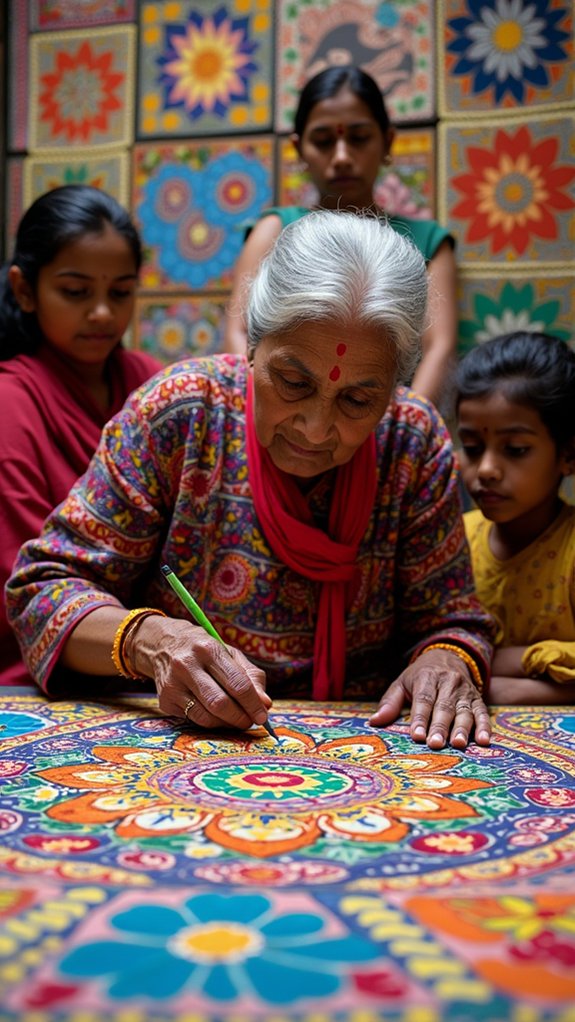
The remarkable story of Madhubani art cannot be told without recognizing the women who have kept its vibrant traditions alive for centuries. In the Mithila region of Bihar, mothers and grandmothers passed down traditional Indian painting techniques to younger generations, weaving cultural narratives into each brushstroke.
Women artists, particularly from the Brahmin and Kayastha communities, transformed household walls into canvases of expression.
The 1960s marked a turning point when these talented creators began using paper and canvas, leading to unexpected economic empowerment. As their work gained recognition, artists like Sita Devi earned prestigious awards, bringing international attention to this folk tradition.
Today, women continue to serve as guardians of Madhubani’s artistic legacy, adapting ancient motifs to modern contexts while honoring their ancestral roots.
Natural Elements and Their Significance in Folk Tradition
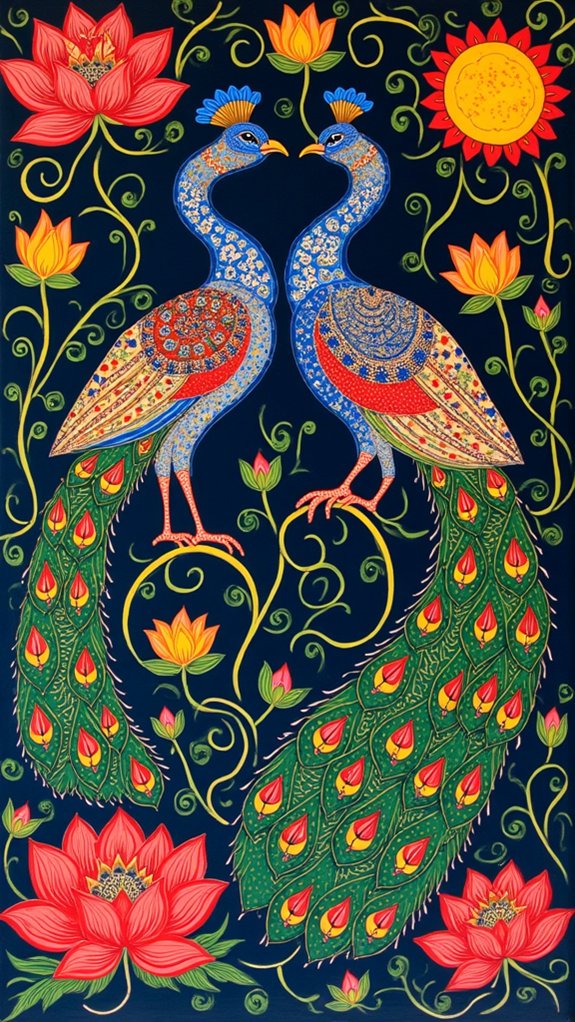
Madhubani artists weave cosmic and earthly elements into their paintings, creating a vibrant tapestry that connects everyday life to sacred traditions.
Fish, lotus flowers, and peacocks aren’t just decorative choices but powerful symbols of fertility, resilience, and love that reflect the community’s deep relationship with nature.
The sun and moon, portrayed in brilliant colors and distinctive patterns, represent divine forces that govern both agricultural cycles and human celebrations, reminding viewers that natural elements form the spiritual backbone of this ancient art form.
Sacred Symbols, Earthly Meanings
Entwined with spiritual beliefs and regional mythology, natural elements in Madhubani art speak a silent language of symbols that locals have understood for centuries.
These intricate designs aren’t just pretty pictures—they carry deep cultural significance in every brushstroke!
- Fish swim through Madhubani paintings as symbols of fertility, showing up at both births and funerals
- The sun and moon pair up to bring divine light and optimism into family homes
- Lotus flowers bloom as an auspicious symbol of female strength and purity
- Trees and colorful flowers connect artwork to the region’s amazing plant life
- Special borders like Singada frame the art with symbols of prosperity and love
These natural elements tell stories that have been passed down through generations, making Madhubani art a living, breathing tradition.
Cosmic Rhythm, Natural Balance
Beyond the painted surface, natural elements in Madhubani art dance to a cosmic rhythm that connects heaven and earth. Fish swim through vibrant compositions symbolizing fertility and prosperity, while the sun and moon—divine figures depicted with radiating lines and gentle curves—oversee the rituals that mark village life.
The ubiquitous lotus, blooming from muddy waters, represents purity and female power, especially during the Chauthchandra festival where it features prominently in offerings. These natural motifs aren’t merely decorative but form a language that speaks to the rich cultural heritage of Mithila.
Elaborate borders filled with local flora and fauna, like the distinctive Singada pattern, create a frame that balances the artwork’s energy, reminding viewers of the natural balance that sustains community life through seasons of celebration and change.
The Evolution From Mud Walls to International Galleries
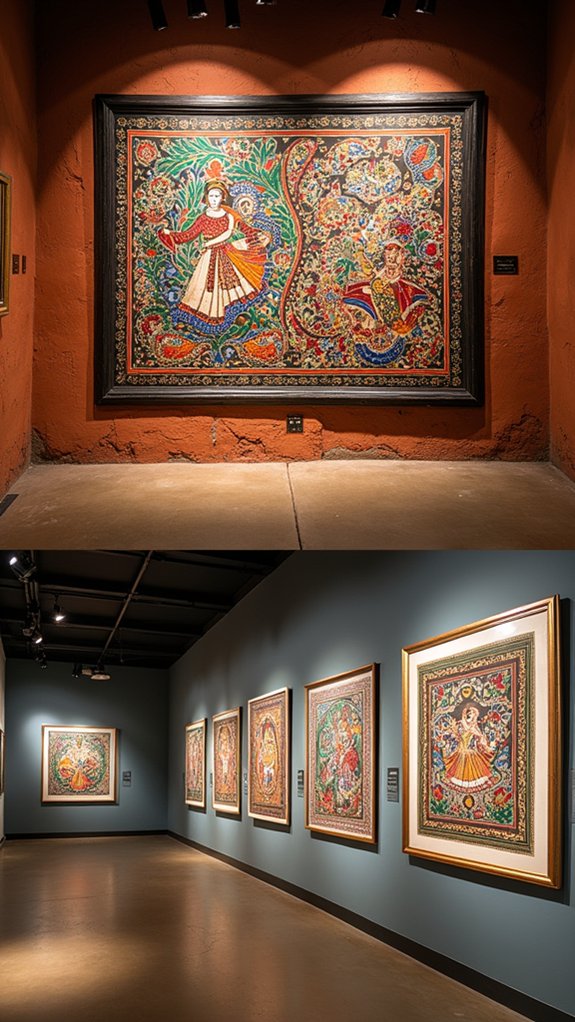
Transformation stands at the heart of Madhubani art‘s remarkable journey from humble village homes to prestigious galleries around the world. This vibrant traditional Indian art from the Mithila region of Bihar was dramatically revealed to outsiders when a 1934 earthquake exposed ancient mud wall paintings, catching the eye of William G. Archer who documented this treasure.
In the 1960s, artists began painting on paper instead of walls—a game-changing shift!
Government programs helped local women earn money through their artwork.
Women’s empowerment bloomed as artists gained financial independence.
By the 1980s, these colorful works achieved international recognition.
The 1995 founding of the Mithila Art Institute cemented the art form’s importance.
Today, these stunning, symbol-rich paintings hang in museums globally, a demonstration of their cultural significance and timeless appeal.
Kohbar Ghar: Wedding Chamber Art and Marriage Rituals
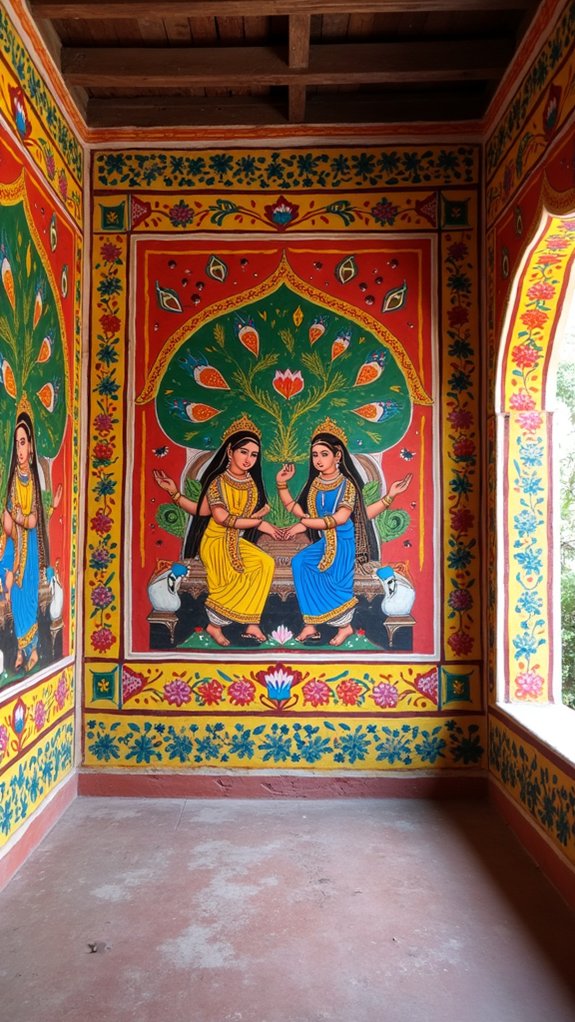
At the heart of Madhubani’s powerful artistic traditions lies Kohbar Ghar, the ceremonial wedding chamber art that has connected generations through color and symbol. This vibrant practice, performed by women of the Mithila community, transforms ordinary walls into stunning visual blessings for newlyweds.
The Kohbar paintings burst with meaningful motifs—lotus flowers, paired fish, bamboo trees, and divine figures—all symbolizing fertility, love, and prosperity. Women apply their intricate designs with natural dyes, creating a sacred space where cultural rituals unfold.
More than just decoration, these colorful masterpieces tell stories and carry wishes. Each careful brushstroke reinforces community values while celebrating the sacred union of marriage.
The wedding chamber becomes a canvas where tradition comes alive, ensuring ancient customs continue to thrive in modern celebrations.
Conservation Efforts and Environmental Impact of Madhubani Art
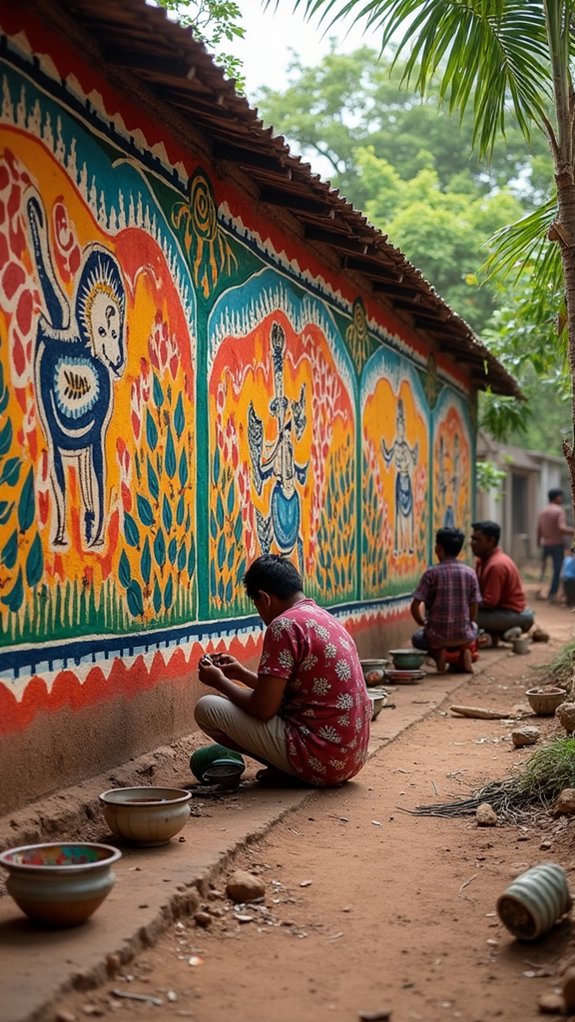
While Madhubani art celebrates cultural heritage through vibrant imagery, it also plays a surprising role in environmental protection across Bihar. Local artists have turned their talents toward conservation efforts, creating a unique blend of cultural preservation and ecological sustainability.
- Painters protect trees by decorating them with religious images, making people think twice before cutting them down.
- Artists use natural dyes from plants, minerals, and even cow dung instead of harmful chemicals.
- Women artists in the 1960s used their earnings to fund local environmental projects.
- Government funding (Rs. 50 million!) supports these sustainable art practices.
- Artwork themes often feature nature scenes, reminding viewers about the importance of protecting their environment.
This colorful tradition doesn’t just preserve stories and culture—it actively helps save the planet through sustainable practices that have been part of Madhubani art for generations.
Notable Artists Who Shaped the Global Recognition of Madhubani
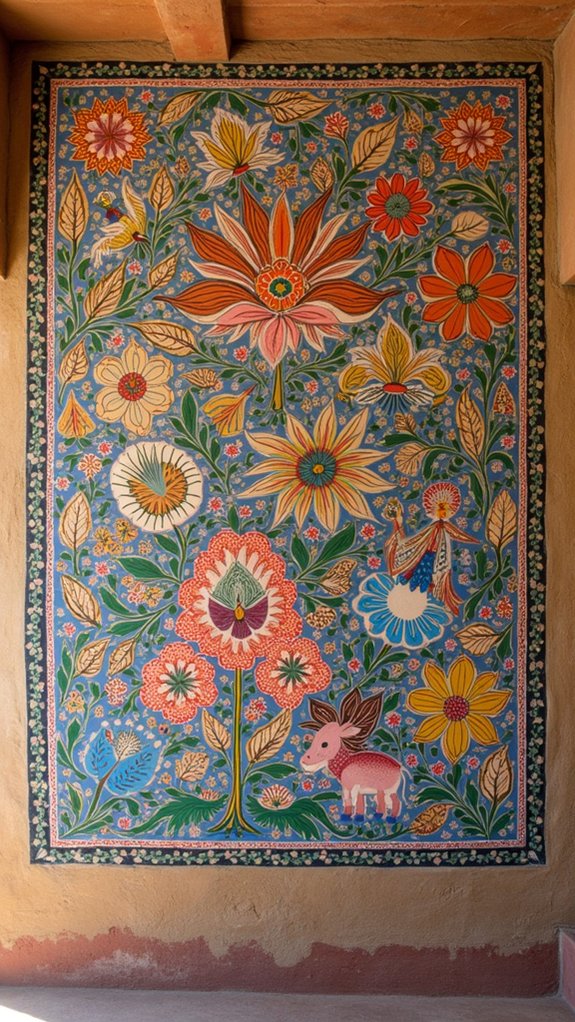
Several incredible women broke through cultural barriers to bring Madhubani art onto the world stage.
Artists like Sita Devi and Ganga Devi, both awarded the prestigious Padma Shri in 1981, transformed what was once a household tradition into an internationally recognized art form through their breathtaking works.
These pioneering painters didn’t just preserve ancient techniques—they reimagined them, blending traditional stories with fresh perspectives that captivated art lovers across continents.
Trailblazing Women Artists
Women have played an indispensable role in bringing Madhubani art to the world stage, with their talent and dedication transforming a local folk tradition into a globally recognized art form.
The vibrant motifs and distinctive techniques of Madhubani art flourished through the paintbrushes of remarkable women artists who received India’s prestigious Padma Shri award:
- Jagdamba Devi (1975) – Pioneer who first brought Madhubani to international audiences
- Sita Devi and Ganga Devi (both 1981) – Created signature styles that defined modern Madhubani
- Mahasundari Devi (2011) – Preserved ancient techniques while introducing innovative elements
- Dulari Devi (2020) – Represents the new generation expanding Madhubani’s relevance
These amazing women didn’t just paint pretty pictures—they preserved cultural heritage, broke barriers, and proved that Indian folk art deserves a place in galleries worldwide!
International Recognition Pioneers
The trailblazing journey of Madhubani art from remote Indian villages to prestigious international galleries didn’t happen by accident—it was championed by extraordinary artists who became cultural ambassadors.
Sita Devi and Ganga Devi, both honored with Padma Shri awards in 1981, broke through international barriers with their distinctive styles. Their recognition opened doors for Madhubani art worldwide!
Mahasundari Devi’s 2011 Padma Shri cemented the tradition’s importance, inspiring countless young artists to pick up brushes.
The establishment of the Mithila Art Institute in 1995 proved game-changing, creating a formal place where traditional techniques could be preserved while encouraging innovation.
These pioneering women transformed what was once village wall art into a globally celebrated art form that carries India’s cultural heart to the world.
Frequently Asked Questions
What Are the Motifs Used in Madhubani Art?
Madhubani symbols encompass nature elements like lotus and fish, mythological figures including deities, geometric patterns within borders, all carrying cultural significance through color symbolism representing purity, fertility, and prosperity.
What Are the Characteristics of Madhubani Art?
Madhubani techniques employ natural pigments on geometric compositions with distinct color symbolism. Artistic tools remain traditional while embracing modern adaptations. This art form carries significant historical significance and reflects deep cultural influences.
What Are the 3 Themes in Madhubani Painting?
Madhubani painting encompasses three primary themes: mythological influences depicting Hindu deities, nature and fertility symbolism featuring cultural significance through regional variations, and social narratives showcasing communal life through traditional artistic techniques.
What Is the Tradition of Madhubani Painting?
Madhubani painting’s tradition encompasses ancient history, cultural significance through ritual art, traditional techniques using natural materials, regional variations across five styles, contemporary adaptations on modern mediums, and rich artistic symbolism representing Hindu mythology.
Conclusion
Madhubani art continues to breathe life into India’s cultural heritage, connecting past and present through vibrant colors and meaningful symbols. What began as humble wall decorations has blossomed into a respected art form worldwide. As artists blend traditional techniques with modern themes, Madhubani’s future looks bright! This beautiful tradition reminds us that art isn’t just pretty pictures—it’s a living story of people, beliefs, and communities that refuses to be forgotten.


Leave a Reply